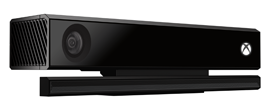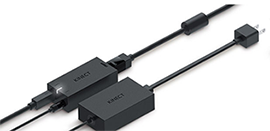Microsoft to consolidate the Kinect for Windows experience around a single sensor
At Microsoft, we are committed to providing more personal computing experiences. To support this, we recently extended Kinect’s value and announced the Kinect Adapter for Windows, enabling anyone with a Kinect for Xbox One to use it with their PCs and tablets. In an effort to simplify and create consistency for developers, we are focusing on that experience and, starting today, we will no longer be producing Kinect for Windows v2 sensors.
Kinect for Xbox One sensor |
Over the past several months, we have seen unprecedented demand from the developer community for Kinect sensors and have experienced difficulty keeping up with requests in some markets. At the same time, we have seen the developer community respond positively to being able to use the Kinect for Xbox One sensor for Kinect for Windows app development, and we are happy to report that Kinect for Xbox One sensors and Kinect Adapter for Windows units are now readily available in most markets. You can purchase the Kinect for Xbox One sensor and Kinect Adapter for Windows in the Microsoft Store.
Kinect Adapter for Windows |
The Kinect Adapter enables you to connect a Kinect for Xbox One sensor to Windows 8.0 and 8.1 PCs and tablets in the same way as you would a Kinect for Windows v2 sensor. And because both Kinect for Xbox One and Kinect for Windows v2 sensors are functionally identical, our Kinect for Windows SDK 2.0 works exactly the same with either.
Microsoft remains committed to Kinect as a development platform on both Xbox and Windows. So while we are no longer producing the Kinect for Windows v2 sensor, we want to assure developers who are currently using it that our support for the Kinect for Windows v2 sensor remains unchanged and that they can continue to use their sensor.
We are excited to continue working with the developer community to create and deploy applications that allow users to interact naturally with computers through gestures and speech, and continue to see the Kinect sensor inspire vibrant and innovative commercial experiences in multiple industries, including retail, education, healthcare, education, and manufacturing. To see the latest ways that developers are using Kinect, we encourage you to explore other stories in the Kinect for Windows blog.
Michael Fry, Senior Technology Evangelist for Kinect for Windows, Microsoft
Key links
- Learn more about Kinect for Windows
- Purchase the Kinect for Xbox One sensor
- Purchase the Kinect Adapter for Windows
- Download the free Kinect for Windows SDK 2.0
Comments
Anonymous
April 02, 2015
The comment has been removed- Anonymous
January 27, 2016
Thank you for your feedback. We will make sure that your comments get to the appropriate recipients.
- Anonymous
Anonymous
April 02, 2015
Dear Kinect team, In case we have a Customer project and need to buy sensors, where we will buy it, under which reference now ? regards- Anonymous
January 27, 2016
The Kinect for Xbox One sensor is available in many markets via the Microsoft Store: http://www.microsoftstore.com/store/msusa/en_US/pdp/Kinect-for-Xbox-One/productID.307499400. (If this URL doesn't redirect automatically to the Microsoft Store page for your locale, please visit your local Microsoft Store online.)
- Anonymous
Anonymous
April 28, 2015
Is the version 1 power adapter compatible with version 2 of kinect?- Anonymous
January 27, 2016
The Kinect for Xbox One sensor requires the use of the Kinect Adapter for Windows, which also works as a spare power source for the previous Kinect for Windows v2 sensor. Learn more about Kinect hardware at https://dev.windows.com/en-us/kinect/hardware.
- Anonymous
Anonymous
February 05, 2016
Kinect for windows v2 sensor having the color resolution of 1080x1920 and depth map of 424x512 pixels. In my project, we need to use both color and depth frames together, however we are facing problem with the alignment color and depth frames (Due to the offset between the Kinect for windows v2 color and depth sensors). Kindly, advise us how to align color and depth frames.Thanks!!!!!!!!- Anonymous
June 01, 2016
Thank you for your interest. For help mapping a color space frame to depth space frame, see the documentation for the MapColorFrameToDepthFrame method on MSDN: https://msdn.microsoft.com/en-us/library/windowspreview.kinect.coordinatemapper.mapcolorframetodepthspace.aspx.If you search on the “MapColorFrameToDepthFrame” method in MSDN, you’ll get numerous results covering Q&A and usage samples in the Kinect Forums, Stack Overflow, and more. For additional technical information, check out our public Kinect for Windows v2 SDK forum, where you can exchange ideas with the Kinect community and Microsoft engineers. You can browse existing topics or ask a new question by clicking the Ask a question button on the forum webpage. Access the forum at http://aka.ms/k4wv2forum. You can find forum discussions about the color and depth streams at https://social.msdn.microsoft.com/Forums/en-US/home?forum=kinectv2sdk&brandIgnore=True&sort=relevancedesc&searchTerm=color+and+depth+streams, or you can search on different terms for other related discussions.
- Anonymous
Anonymous
June 21, 2016
Does Kinect for Windows V2 sensor support multiple sensors connected to a single PC?- Anonymous
August 19, 2016
No, it doesn't, due to the amount of data that is transmitted over Kinect via USB 3. People who want to integrate multiple Kinect v2 sensors have joined multiple machines together and used a networking sequencer to have them do the equivalent of 360 panoramic captures. Alternatively, people have put objects/people on a turntable and rotated them to get the same effect with one Kinect v2 sensor.If you have additional technical questions, be sure to check out our public Kinect for Windows v2 SDK forum, where you can exchange ideas with the Kinect community, including other developers and Microsoft engineers. You can pose a question to the community by clicking the Ask a question button or browse topics already under discussion.
- Anonymous

